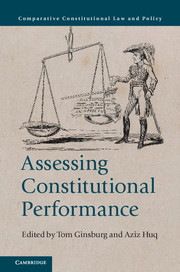Book contents
- Frontmatter
- Contents
- List of figures
- List of tables
- List of contributors
- Acknowledgments
- INTRODUCTION
- PART I DEFINING CONSTITUTIONAL PERFORMANCE
- PART II MANAGING SPECIFIC CONSTITUTIONAL CHALLENGES
- PART III CASE STUDIES
- 11 Ambedkar's constitution: Promoting inclusion, opposing majority tyranny
- 12 Assessing the Constitution of Kenya 2010 five years later
- 13 The Arab Spring constitutions: For whose benefit?
- 14 Stability in flexibility: A British lens on constitutional success
- Index
- References
12 - Assessing the Constitution of Kenya 2010 five years later
from PART III - CASE STUDIES
Published online by Cambridge University Press: 05 August 2016
- Frontmatter
- Contents
- List of figures
- List of tables
- List of contributors
- Acknowledgments
- INTRODUCTION
- PART I DEFINING CONSTITUTIONAL PERFORMANCE
- PART II MANAGING SPECIFIC CONSTITUTIONAL CHALLENGES
- PART III CASE STUDIES
- 11 Ambedkar's constitution: Promoting inclusion, opposing majority tyranny
- 12 Assessing the Constitution of Kenya 2010 five years later
- 13 The Arab Spring constitutions: For whose benefit?
- 14 Stability in flexibility: A British lens on constitutional success
- Index
- References
Summary
In this chapter, I assess the implementation of Kenya's 2010 Constitution, one of the most important efforts in recent years to transform a political culture through constitutional change. Using a case-study approach, I assess the successes, challenges, and failures in meeting the Constitution's ambitious reform agenda. I then offer explanations for these varied outcomes.
The reforms required by the 2010 Constitution have been implemented with varying degrees of success, in fits and starts, as well as with varying speeds. Although the judiciary has transformed to become relatively more independent of the Executive than before the 2010 Constitution, its empowerment has been met with backlash, particularly from Parliament. In addition, corruption in the judiciary has continued. By contrast, the anti-corruption authority, the Ethics and Anti-Corruption Authority (EACC), recognized for the first time as an independent organ in the Constitution, has been hampered by its continued inability to prosecute and instead has had to depend on the Director of Public Prosecutions to prosecute suspects. Parliament has since the adoption of the 2010 Constitution been instrumental in the removal of two EACC Chief Executive Officers as well as other senior officials. Thus, the constitutionalization of leadership and integrity principles stands in sharp contrast to continued widespread corruption in all branches of government including in the newly established regional system of governance. A number of factors including new leadership and a swathe of new judges have been critical to the progress made in the judiciary, and the absence of such leadership in the EACC, as well as the lack of a consistent commitment to combat corruption in both the Executive and the Legislature, is a major explanation for the relative difference in outcomes. The resulting picture is one which reminds us of the need for political will to effectuate institutional transformation.
I also attribute the relative success in judicial reform to the highly energized civil society movement, which includes activist lawyers and individuals who have been at the forefront in monitoring the implementation of the Constitution and testing its contours in Court. In addition, donors have provided additional encouragement and funding to assist the very expensive process of implementing these constitutional changes.
- Type
- Chapter
- Information
- Assessing Constitutional Performance , pp. 337 - 364Publisher: Cambridge University PressPrint publication year: 2016
References
- 2
- Cited by

